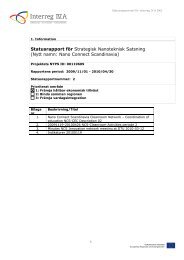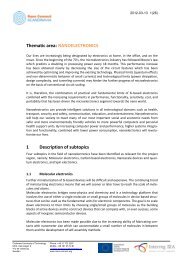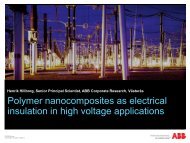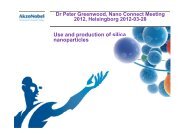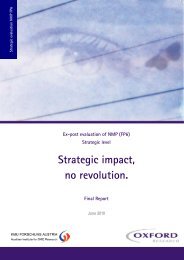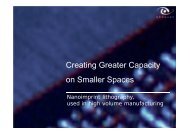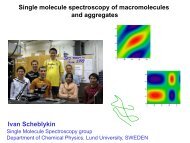Underwater electric field sensor and amplifier - Nano Connect ...
Underwater electric field sensor and amplifier - Nano Connect ...
Underwater electric field sensor and amplifier - Nano Connect ...
Create successful ePaper yourself
Turn your PDF publications into a flip-book with our unique Google optimized e-Paper software.
<strong>Underwater</strong> <strong>electric</strong> <strong>field</strong> <strong>sensor</strong><br />
Eric Östlund, stlund, CEO<br />
DC/DC converters<br />
Degaussing systems<br />
Signature measurements<br />
UEP/ELFE Sensor
<strong>Underwater</strong> Electric Field/Potential<br />
Field/Potential
<strong>Underwater</strong> Electric Potential<br />
The voltage potential between two metals, in the<br />
salt water electrolyte, form a galvanic cell
<strong>Underwater</strong> Electric Potential UEP<br />
A rusting ship is a galvanic cell
<strong>Underwater</strong> Electric Potential UEP<br />
A rusting ship is a galvanic cell
Moving Electric <strong>field</strong> ELFE
<strong>Underwater</strong> Electric Potential UEP<br />
The voltage potential in the water between<br />
two points close to a galvanic cell
ELFE = UEP + MOVEMENT<br />
F < 10 Hz<br />
If the anode or cathod<br />
is moving or the water<br />
flow around it changes<br />
the UEP will be<br />
modulated
ELFE = UEP + ”Ground Ground fault” fault<br />
If the ships <strong>electric</strong>al<br />
system is ”leaking leaking” to<br />
water the UEP will be<br />
modulated with the<br />
power grid frequency<br />
(60 HZ)
ELFE = UEP + ”Ground Ground fault” fault<br />
If the ships <strong>electric</strong>al<br />
system is ”sparking sparking” to<br />
the water the UEP will<br />
show spikes
Potential<br />
mines<br />
Active Shaft Grounding
UEP + ELFE
Why is it important?<br />
Measurement of ships electromagnetic<br />
signature<br />
Detection <strong>and</strong> classification<br />
Protection from mines <strong>and</strong> torpedoes<br />
Used in moored mines
COUNTER MEASURES
Impressed Current Cathodic<br />
Protection ICCP
Noise - the environment
Summary applications<br />
Near <strong>field</strong> measurements of signatures<br />
Tracking submarine movements<br />
Submarines<br />
Harbour protection – subscoters, subscoters,<br />
divers<br />
New <strong>and</strong> old Oil <strong>and</strong> Gas <strong>field</strong> mapping<br />
Submerged equipment status control<br />
Drill head control<br />
Corrosion control systems
Environmental data<br />
More applications<br />
Wave profiling<br />
Stream measurements<br />
Ionospheric measurements<br />
Earth quake warning<br />
Practical frequencies<br />
5 mHz to 15 Hz environmental <strong>and</strong> ELFE<br />
5 mHz to 500 Hz man made equipments UEP/ELFE
The natural <strong>sensor</strong> <strong>and</strong> platform<br />
Ampullae de Lorenzini<br />
Is a multi <strong>sensor</strong>y <strong>sensor</strong><br />
•Electromagnetics<br />
•Temperature<br />
•Pressure<br />
•Salinity<br />
Source: Wikipedia
AgAgCl or Silver/SilverChloride<br />
Silver/ SilverChloride<br />
Zn Zink electrodes<br />
Human Sensors<br />
Carbon fibre
Platforms
Long base system<br />
FOI<br />
Orienterar om<br />
Sensorer Nr 3 2004
UEP Typically 1500 m
Sensors = Contact with water<br />
Smaller footprint<br />
Polyamp second<br />
generation <strong>sensor</strong>s<br />
Polyamp first<br />
generation<br />
<strong>sensor</strong><br />
FOI <strong>sensor</strong>
Carbon fibre<br />
The Carbon fibre is selected <strong>and</strong> cleaned to<br />
maximise the surface to the water with nano<br />
structures<br />
The <strong>sensor</strong> surface is around 4 m 2<br />
The, in air resistance, is < 0.1 Ωm<br />
between Carbon fibre <strong>and</strong><br />
connector<br />
Highly capacitive 0.5F in sea water<br />
Depth rated to 2500 m (250 bar)
<strong>Nano</strong> volt differential <strong>amplifier</strong><br />
Amplifier Noise level 0.7nV with 1/f at 0.1 Hz<br />
Measures 1nV/m Root Hz @ 1 Hz<br />
Sensor distances for UEP 0.5 m<br />
Sensor distances for ELFE 2 to 100 m<br />
Galvanic separation between input output<br />
Amplification 60 to 86 dB
No!<br />
Successful ?<br />
Un-traditional Un traditional <strong>sensor</strong> more expensive<br />
Everything below 1 m Sea surface is secret<br />
FOI receive all research money.<br />
No money to the “industry industry”<br />
Oil industry attitude deliver only to me.<br />
Component supplier or System supplier?
What shall we do?<br />
Modify the <strong>amplifier</strong><br />
Multichannel 24 bit A/D board with Ethernet<br />
Possibly make the <strong>sensor</strong> even more <strong>Nano</strong><br />
Smaller footprint easier to integrate into a<br />
platform.<br />
Better work condition – now special location<br />
Opens up for new applications<br />
How to protect the technology?
<strong>Nano</strong> <strong>sensor</strong><br />
Is this our new <strong>sensor</strong>?<br />
Through silicon vias filled with planarized carbon<br />
nano tubes.<br />
Teng Wang, Kjell Jeppson, Niklas Olofsson,<br />
Eleanor E B Campbell <strong>and</strong> Johan Liu



